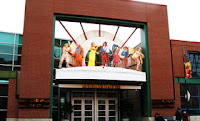 |
| Apple Store |
Let's use Apple as an example. First, they rightfully looked past their retail and technology competitors. They based none of their retail positioning or experience on Best Buy, Comp USA or others. Remember, the "prudent" plan would have been to compete with the big box stores that were the market leaders, and incredibly successful at the time.
Second, they looked not at the then current user of Apple products, but rather at the huge potential audience. They then reinforced their brand by modeling their experience after their product: clean, fresh and intuitive.
Third, they kept the retail footprint small, allowing them to enter higher traffic, more "upscale" developments.
Finally, they created the entire in-store experience to connect with their online experience. The Genius Bar is the human face of their online support.
 |
| Hallmark Gold Crown Store |
First a few facts. In a Retail Info Systems News article, Hallmark says that it has over 4,000 principle stores called Gold Crown, 500 of which are owned by the company and the rest are franchise operations. The real revenue is generated from the 43,000 other outlets that sell their greeting cards and gifts, from Walmart to gas stations. This accounts for an estimated $4.1 billion in revenue annually. The greeting card industry is facing a monumental consumer shift as fewer cards are mailed and people move to more electronic and social media for celebrating major "life events." Hallmark has some very smart people tackling these issues around how to keep Hallmark relevant in the 21st Century. But as they innovate with product, they seem to be neglecting arguably the most important part of their brand experience, the store.
As their retail experience has languished, it has reached a point where a fresh coat of paint or a new retail end cap will not do it. Hallmark retail needs a radical makeover. One that will reposition them for the future and highlight their product innovation in the proper way.
Here are five ideas to kick start that process.
1. Stores as Brand Tool: Recognize that the Gold Crown Stores, especially the company owned ones, are primarily a brand marketing tool. Launch a "blue sky" rename and rebrand of these stores to position the brand well beyond its current perception. Think uncluttered, fresh and contemporary. Let the product be the pop of color. Rethink the signage and overall look and feel and approach it from a fashion, art and design direction.
2. Smaller and Higher Profile: Move to smaller retail footprints in high traffic, urban and power centers. Open up the exteriors to be primarily glass and corner activated. This will compel the casual visit and generate a higher pass-through volume.
3. Curate Product Content: The trend of "buy local" continues to grow and evolve. Hallmark should serve as the leader in providing the best in emotional messaging. This goes beyond their own creative materials. In fact, Hallmark already has an entire trend department dedicated to tracking and recording trends within their industry. Instead of identifying what products in the marketplace are competitors and then attempting to counter them, Hallmark experts should be hand-selecting cards, posters and gifts that are designed and made locally in each market to feature in their stores. This would allow them to bring the latest trends to the consumer faster and better reinforce their new tagline and campaign theme that "Life is a special occasion," challenging consumers to stop and enjoy life's perfectly imperfect, unplanned moments.
5. Social Media Connectors: Each store should then activate a localized online "Genius Bar" of sorts by becoming the local hub via bricks-and-mortar and social media for celebrations. Both in the store and online, the staff of that store will be dedicated to proactive management of customer relationships. Guide customers to in-store product and various online product via Hallmark.
The above ideas are simply those of a brand and retail marketing expert who loves Hallmark. I am looking from the outside and crafting suggestions as an example of how a large retail brand could (and should) reshape how they operate in order to be more relevant in the future.
Feel free to share your feedback here or better yet, mail me a Hallmark card.






